House Plans With Bedrooms On Opposite Sides
Split Bedroom Floor Plans (with Drawings)
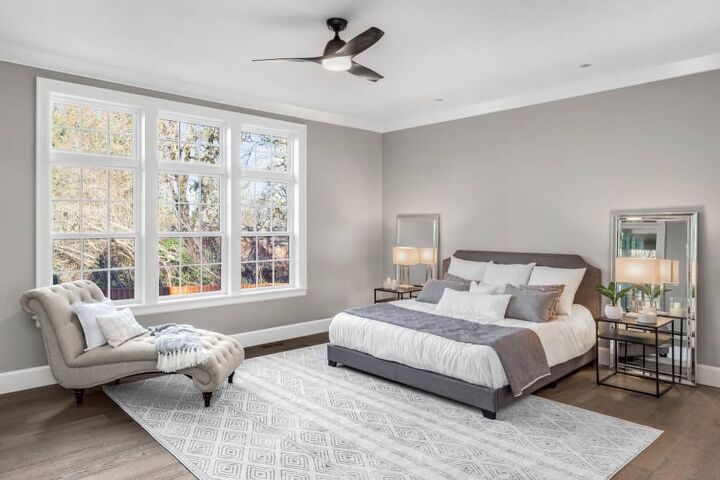
There comes a time as a parent when you prefer to go to bed early and wake up early. The problem is that your teenage kids are on the opposite schedule from you. If you need a way to maintain privacy while keeping noise to a minimum, consider a split bedroom floor.
A split bedroom floor plan separates the master suite from other bedrooms. The master suite can be opposite additional bedrooms in a one-story house. In a two-story house, the master suite can be on the main story with other bedrooms on the second story.
Table of Contents
- What Is a Split Bedroom Floor Plan?
- Advantages of a Split Bedroom Floor Plan
- Offers Privacy
- Allows for More Open Space
- Good for Older Children
- Good for Guests
- Customization Options
- Disadvantages of a Split Bedroom Floor Plan
- Can Make Child Care Difficult
- Hinders Family Time
- Difficult to Move Around
- Types of Split Bedroom Floor Plans
- Two-Bedroom Split Floor Plan
- Three-Bedroom Split Floor Plan
- Master Bedroom on Opposite Side of the House
- Master Bedroom on the Main Story of a Two-Story House
- Related Questions
-
- How many bathrooms should my split bedroom floor plan have?
- What is a split-level house?
- How do you add privacy to a home that has an open floor plan?
- More Related Guides
-
What Is a Split Bedroom Floor Plan?
A split bedroom floor plan has the master suite separated from the other bedrooms. You can do this by putting the living room between the bedrooms or placing them on different floors. This arrangement can create more privacy for the master suite and give children their own space, ideal for families.
A split bedroom floor plan can decrease the need for hallways and interior walls, preserving more square footage. When divided into multiple stories, the master suite is typically on the ground level. This is beneficial for the parents for many years, even after the kids move out.
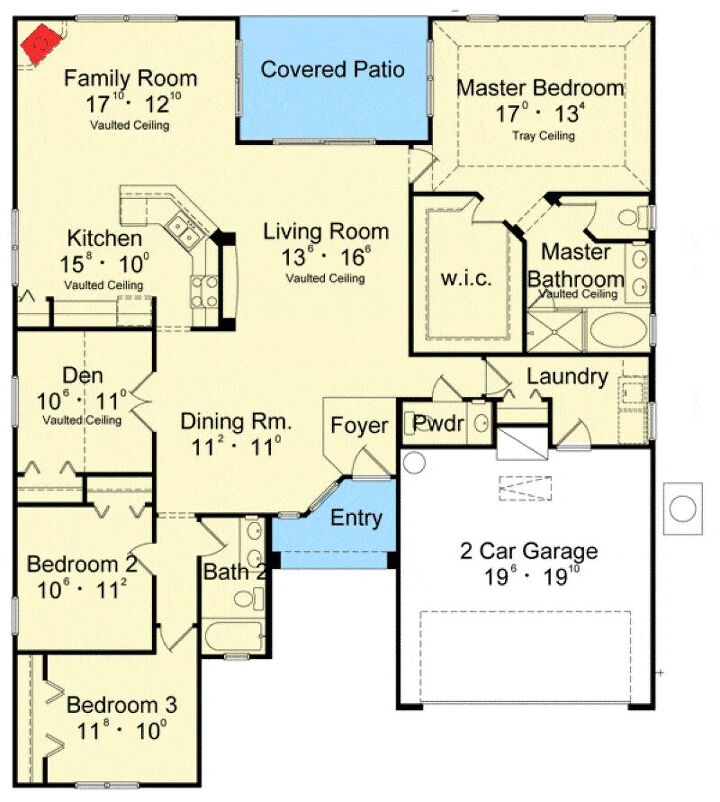
Advantages of a Split Bedroom Floor Plan
Offers Privacy
Privacy is an advantage of a split bedroom floor plan if you are living with family members. This can ensure that each person feels that they have their own space and don't feel intruded on. A split-bedroom floor plan can also reduce noise, since sound doesn't travel easily to other rooms.
Allows for More Open Space
Open space is a benefit of split-bedroom floor plans because the design creates efficient use of space. A split-bedroom floor plan eliminates the need for hallways while opening space in the kitchen or living room.
Good for Older Children
If you have children, a split-bedroom floor plan can help parents maintain their privacy. The children, in turn, won't have to worry about disturbing their parents. This is especially beneficial if you have teenagers or college-aged kids living with you.
This also helps when adult children come to visit you. The parents won't be bothered by having extra people in the house. The same goes for parents visiting their children; they won't feel intrusive.
Good for Guests
The privacy of you or a houseguest is not compromised when you have a split-bedroom floor plan. Everyone can stay on their respective sides of the home.
No one's daily routine will be disturbed. This floorplan is popular for people who often have family or friends visiting.
Customization Options
When you have a split-bedroom floor plan, you can customize it to your liking. You can convert bedrooms into offices or workout rooms after the need for a bedroom is gone. This is an excellent option to utilize the current rooms without having to expand your home.
Disadvantages of a Split Bedroom Floor Plan
While split-bedroom floor plans come with a variety of benefits, they also come with some disadvantages.
Can Make Child Care Difficult
A split-bedroom floor plan may not be best for couples with an infant or young children. While privacy is desirable, having a split-bedroom design tends to cut off parents from the children. If you have young children, you may not hear them on the other side of the house.
This floorplan can force parents to have their babies sleep in the same room as them for a longer time. It can be a hassle to travel from the master bedroom to other rooms.
Hinders Family Time
Another disadvantage of the split-bedroom floor plan is that the family can feel separated from one another. While the floor plan creates privacy, the layout can cut family members off from each other for more extended periods.
Difficult to Move Around
Depending on the layout of your split-bedroom floor plan, it may be challenging to move around the house. With a multi-story house, there's a disadvantage of climbing stairs to get to other parts of the home. This can be inconvenient for those who have disabilities or for people at an older age.
Types of Split Bedroom Floor Plans
Whenever bedrooms are separated from each other and don't share common walls, this is a split-bedroom floor plan. More often than not, the master suite is away from other sleeping areas. This tends to elevate the value of the home because there is more separation between bedrooms.
There are several types of split-bedroom floor plans to make each homeowner's layout conducive to their daily routine.
Two-Bedroom Split Floor Plan
Two-bedroom split floor plans make each bedroom an extension of the living area. This is a popular way to delegate floor space while making the living room the center of the household. This can also allow the dining and kitchen areas to serve as a hub for the rest of the house.
Sometimes, architects can place a floor between the bedrooms to create more separation between the two. This creates fewer hallways and allows more extensive living areas. When dividing bedrooms by stories, the master suite is usually on the ground level, and the second bedroom is upstairs.
In either case, the en-suite bathrooms add more privacy and separation while also giving the floor plan a spacious look.
Three-Bedroom Split Floor Plan
There's not much difference between a two-bedroom and three-bedroom split floor plan. However, when there are more bedrooms in the home, you can encounter more configurations. Sometimes all three bedrooms occupy the same floor, while other times, the master suite is downstairs, and additional bedrooms are upstairs.
Whether a two-bedroom or three-bedroom split floor plan, the defining feature is that none of them share a common wall.
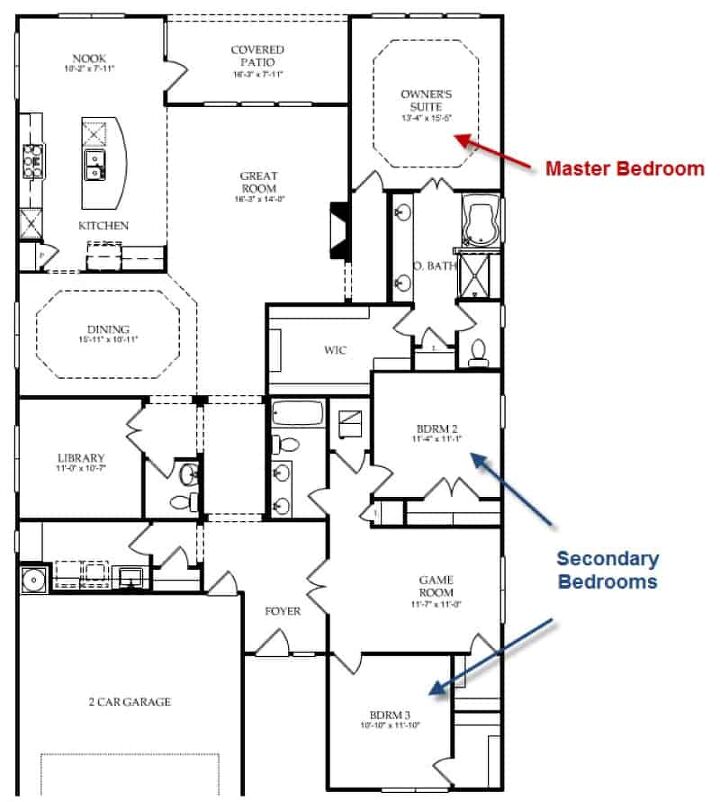
Master Bedroom on Opposite Side of the House
A common layout for one-story split-bedroom homes is the master bedroom is on the opposite side of the house. When the master suite is on the opposite side of the house, it can ensure that the room feels private. This is especially true for homes that have smaller square footage.
Because the master is set apart by the living and dining areas, it gives the illusion that the home is bigger. Some architects draw the plans so that the house has "wings" for a symmetrical appearance. This is when the master suite is on one side, and the extra bedrooms are on the other.
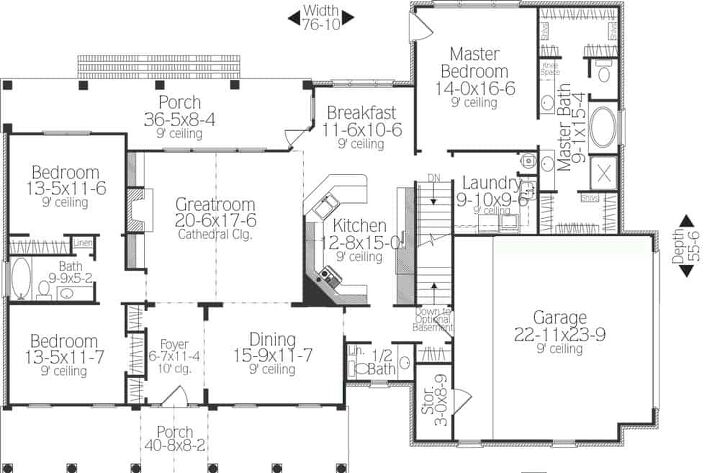
Master Bedroom on the Main Story of a Two-Story House
If you're building a multi-story home, the master suite will likely be on the main level. When separating other bedrooms on the upper level, this creates a split-bedroom floor plan. This is the most popular layout for multiple-story homes.
This layout leaves the master suite accessible on the main level to eating and living areas. However, it is still away from the rest of the home, so it remains private.
This works well for a four-bedroom home because of the "stacked" concept. It allows space for multiple bedrooms and gives each bedroom access to outside views without cramming bedrooms together.
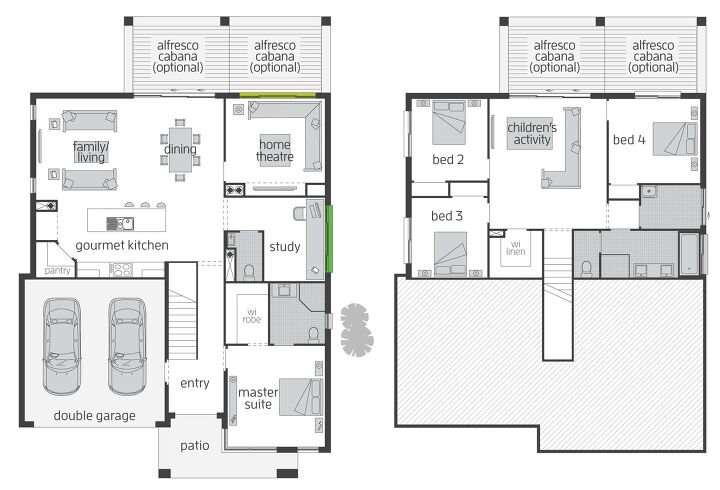
How many bathrooms should my split bedroom floor plan have?
For most homeowners, the average ratio is at least two bathrooms for every three bedrooms. In most cases, three-bedroom homes will likely have a master bathroom and a family bathroom for children and guests.
In a five-bedroom house, there is typically a master bathroom, a bathroom for children and guests, and another en-suite bathroom. This second en-suite bathroom can be set aside for guests.
In more modern homes, it's becoming common to have a bathroom in every room. This ensures that everyone is comfortable and has their own space. While this is useful, it can become expensive and require extra space, fixtures, and fittings for each bathroom.
What is a split-level house?
A split-level house is a home that has staggered levels. This means that when you enter the front door, there may be staircases going to other levels. You may find that one staircase goes to the bedrooms while another staircase takes you to the basement.
There are at least three levels in a split-level house, the kitchen and dining room being on the main level. The basement area typically serves multiple purposes, including a bedroom and laundry room. Some split-level homeowners turn the basement into the primary living area, but no one floor covers the house's entire footprint.
When deciphering between a craftsman house with multi-levels and a split-level house, remember how the floors are stacked. A craftsman house has floors that overlap each other, while split-level homes are staggered.
How do you add privacy to a home that has an open floor plan?
An open floor plan can provide an airy atmosphere. To incorporate privacy without sacrificing the spacious feel, use individual pieces of furniture to create private spaces without adding walls. Bookcases, plants, dividers, screens, and art can add character while forming personal space.
An open bookcase with wide and deep cubicles creates a place to store bins, hiding miscellaneous items. The bookcase with shelving can look good from both sides to create a hallway.
Plants can also create space while incorporating a nice visual. When open floor plans have an abundance of natural light, stagger plants along the floor, or hang them from above. This can create a wall of greenery and direct foot traffic between spaces.
Dividers and screens are an easy way to add a wall between two areas. Place a divider behind the couch to form a conversation area or between rooms for a formal feel. Large pieces of art can visually separate areas and add a quaint and charming appeal.
- Two-Bedroom Apartment Floor Plans
Stacy Randall
Stacy Randall is a wife, mother, and freelance writer from NOLA that has always had a love for DIY projects, home organization, and making spaces beautiful. Together with her husband, she has been spending the last several years lovingly renovating her grandparent's former home, making it their own and learning a lot about life along the way.
Recently Published
House Plans With Bedrooms On Opposite Sides
Source: https://upgradedhome.com/split-bedroom-floor-plans/

0 komentar:
Posting Komentar